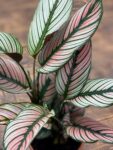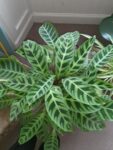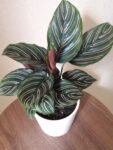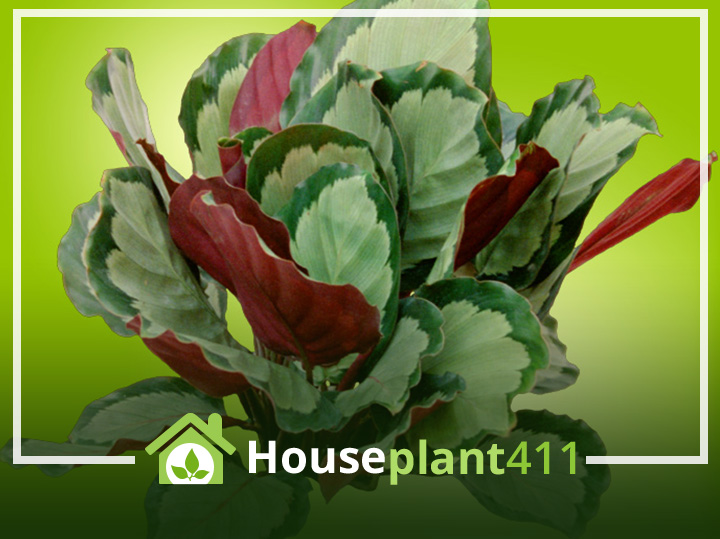About
A calathea plant, native to tropical South and Central America, Africa, and the West Indies, is grown primarily for its beautiful, brightly colored, upright, oval leaves. It is member of the Marantaceae group. There are four closely related plants in the Maranta group, the Calathea, Prayer plant, Ctenanthe, and the Stromanthe. Of the four, the calathea is the most difficult to grow indoors. There are over 300 different types of calathea plants, many being man-made hybrids created by tissue cultures.
Calathea Plant Description
The many different calathea varieties have leaves with a purple underside and vibrant, colorful patterns on the top side. Indoors, it is a low growing table plant or short bush that rarely gets taller than 10.” It can, however, spread out 24”-26” wide. The leaves of a calathea plant are much more spectacular than the purple, yellow, or white flowers that may develop during the summer.
Popular Calathea Plant Varieties (all have purple undersides)
C. Lubbersii – Long, oval leaves with splashes of bright yellowing green
C. Lancifolia or Rattlesnake Plant – Long, narrow leaf with wavy edges, and dark green splotches
C. Majestic “Whitestar” – Dark green and white stripes from the midvein to the leaf edges; mature plants in bright light have shades of pink.
C. Zebrina – Long, oval leaves with a velvety surface and a dark green pattern
C. Ornata – Pale pink stripes on broad, oval green leaves




Calathea Whitestar Calathea Rattlesnake Calathea Zebrina Calathea Ornata
Quick Care Tips
Warm temperatures above 60°F
Bright light but no direct sun
Keep soil barely moist at all times
Provide high humidity
Problems
Leaf tips turn brown-increase the humidity
Leaves burned and discolored- too much bright light, move to a shadier spot
Leaf drop – air is too dry, increase the humidity
Leaves turn yellow and curl – Plant needs more water
Conclusion
A calathea with its exotic foliage, is a bit difficult to care for and has very specific water, light, and fertilizer requirements. However, like many other fussy plants, a calathea plant is well worth the effort. This very attractive plant is safe to have around children and pets.
Plant Care
Light
How much light does a calathea plant need: A calathea plant likes bright indirect light; so placing it in front of an east, west, or north window is ideal. Too much direct sun burns the leaves and causes the beautiful leaf colors to fade.
Water
How to water a calathea plant: Calathea plants are very sensitive to the water you use. Hard water, soft water, fluoridated water, or water of poor quality causes ugly, brown leaf burn. The best way to water is to use distilled water, rain water, or allow your tap water to sit out over night before using it. Keep the soil of a Calathea plant barely moist but never soggy. Allow the top 2-3” to dry out before watering and never allow the plant to sit in the excess water.
Fertilizer
Feed a Calathea plant monthly in the spring, summer, and fall with a balanced plant food diluted to ½ the recommended strength. Don’t fertilize if the plant is not growing.
Temperature
Calatheaplants like temperatures between 65°-80°F (18.3°-26.7°C), and do not like cold drafts or temperatures below 55°-60°F (12.8°-15.6°C). Hot temperatures cause the leaves of a Calathea plant to curl.
Humidity
High humidity is a must! A Calathea plant gets brown leaf edges when the air is too dry. Humidity can be increased by placing your plant on a tray of wet pebbles (be sure the pot is on the pebbles and not in the water), setting a humidifier close by, or by grouping plants together to create a greenhouse effect.
Flowering
The leaves of a Calathea plant are more beautiful than many of the flowers on other indoor plants. With over 300 varieties of Calathea plants, some types such as Calathea Crocata, White Ice, and Brazilian have lovely flowers as well as spectacular leaves.
Pests
Spider Mites, Scale, Mealy Bugs and Aphids are houseplant pests that can be a problem for a Calathea plant.
Diseases
The high humidity that a Calathea plant needs also encourages bacterial and fungal diseases which usually manifest themselves as leaf lesions.
Soil
Use a good, light, porous indoor potting soil that retains water but still drains quickly for a Calathea plant. African Violet soil works well.
Pot Size
A Calathea plant rarely needs repotting. Moving a calathea plant to the next size pot should only be done when the roots have filled the existing pot.
Pruning
Cut off the brown or crispy leaves on a Calathea plant as soon as they appear.
Propagation
A Calatheas plant is propagated by plant division but it is a difficult process and not always successful.
Poisonous Plant Info
A Calathea plant is a non-poisonous plant and safe to have around young children and your pets.
FAQ
It’s a great idea to use water from a fish tank to fertilize a calathea plant. Your calathea plant will love everything the water has in it.
The leaves of a calathea plant curl under when the temperature is too warm or the calathea plant is in an area that is too bright.
A Calathea plant is a very fussy plant and the leaves get brown tips, brown spots, or brown edges very easily. Here are some things that might be causing the problem with your calathea plant: water with too many chemicals or if it is too hard or too soft, over fertilization, direct sun, lack of humidity, and plant diseases.
The flowers of a calathea plant are usually quite attractive and you should let them stay on the plant as long as possible and enjoy them. With plants like a Coleus, that has beautiful leaves and small inconsequential flowers, I recommend immediately pinching off the flowers.

